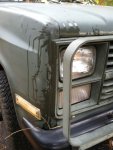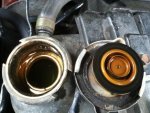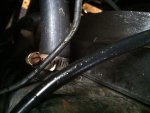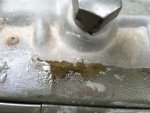I ran an errand today, about 10 miles, max speed 45 MPH. When I got home, I noticed wetness around the passenger headlight. It was coolant. The "overheat" idiot light never went on. The cooling system has been flushed twice recently, once at 1,900 miles, and again at 2,500 miles. Mileage is now 4,400. The coolant is less than 50% water. I recently replaced the lower radiator hose, which hasn't shown any sign of leakage recently. When it was leaking, I used a radiator cap with no pressure washer, to minimize leakage. Today was my third trip with a pressurized cooling system since fixing that leak. When the engine is hot, the upper radiator hose is hard, and I find no leaks.
In the photos, you can see where the coolant sprayed. The radiator had about 1/2" of air at the top when I opened the cap (after it was cool). I thought I had eliminated all the air, but perhaps not. The overflow tank was down about 1/2" from where I filled it a week ago.
Clearly, I need to top off the radiator and the overflow tank. I don't know how old the radiator cap is. It looks OK, but I can certainly replace it.
Does this indicate a problem in my cooling system? Or is it as simple as a new radiator cap?
Thanks in advance for all advice and wisdom. I'm still a CUCV newbie.




In the photos, you can see where the coolant sprayed. The radiator had about 1/2" of air at the top when I opened the cap (after it was cool). I thought I had eliminated all the air, but perhaps not. The overflow tank was down about 1/2" from where I filled it a week ago.
Clearly, I need to top off the radiator and the overflow tank. I don't know how old the radiator cap is. It looks OK, but I can certainly replace it.
Does this indicate a problem in my cooling system? Or is it as simple as a new radiator cap?
Thanks in advance for all advice and wisdom. I'm still a CUCV newbie.






